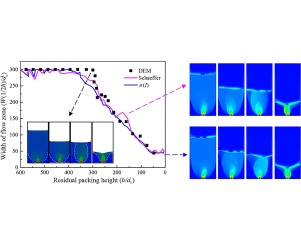Particuology ( IF 4.1 ) Pub Date : 2017-07-17 , DOI: 10.1016/j.partic.2017.04.001 Tian Tian , Jinglin Su , Jinhui Zhan , Shujun Geng , Guangwen Xu , Xiaoxing Liu

|
Granular material discharge from a flat-bottomed silo has been simulated by using continuum modeling and a three-dimensional discrete-element method (DEM). The predictive abilities of three commonly used frictional viscosity models (Schaeffer, S–S, and μ(I)) were evaluated by comparing them with the DEM data. The funnel-flow pattern (type C) and the semi-mass-flow pattern (type B) that was predicted by DEM simulations can be represented when the Schaeffer or μ(I) model is used, whereas the S–S model gives a consistent type-B flow pattern. All three models over-estimate the discharge rate compared with the DEM. The profiles of the solids volume fraction and the vertical velocity above the outlet show that the larger discharge rates given by the Schaeffer and μ(I) model result from an over-estimation of volume fraction, whereas the deviation in the S–S model stems from the failure to predict a solid vertical velocity and a volume fraction.
中文翻译:

筒仓卸料中颗粒流的离散和连续模型
通过使用连续模型和三维离散元素方法(DEM),对平底仓仓中的颗粒物料排放进行了模拟。通过将它们与DEM数据进行比较,评估了三种常用的摩擦粘度模型(Schaeffer,SS和μ(I))的预测能力。当Schaeffer或μ(I)模型,而S–S模型给出了一致的B型流型。与DEM相比,这三个模型都高估了放电率。固体体积分数和出口上方的垂直速度的分布图表明,Schaeffer和μ(I)模型给出的较大排放速率是由于对体积分数的高估而引起的,而S–S模型的偏差则是由不能预测固体的垂直速度和体积分数。











































 京公网安备 11010802027423号
京公网安备 11010802027423号